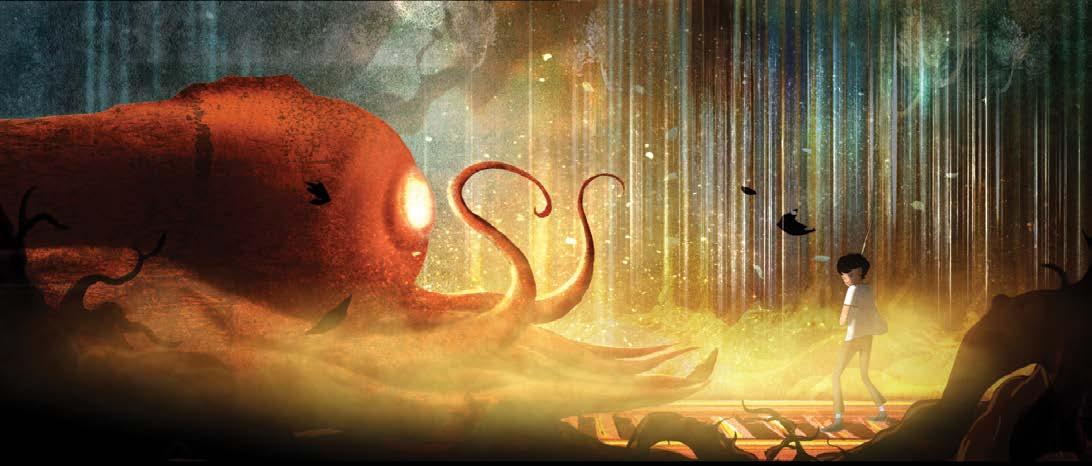previous page
TOC
Features
Comedy Classics
D
irector Tim Story and his animation team pay homage to some of the cartoon duo’s greatest hits in the new movie: Among them: Mouse Trouble. Tom tries to follow a book’s advice on how to get rid of mice in this 1944 Oscar winner for Best Short Subject, Cartoons. Directed by William Hanna and Joseph Barbera, it was produced by Fred Quimby and featured animation by Ray Patterson, Irven Spence, Ken Muse and Pete Burness, with music direction by Scott Bradley. Cat Concerto. This 29th Tom and Jerry short was released in theaters in April 1947. Produced by Quimby and directed by Hanna and Barbera with music supervision by Bradley, the short featured animation by Ed Barge, Muse and Spence. The short finds concert pianist Tom in a formal tuxedo playing “Hungarian Rhapsody No. 2”, which wakes Jerry who is sleeping inside the piano. Mayhem ensues! The short won the Oscar for Best Short Subject, Cartoons, giving Tom and Jerry their fourth consecutive win at the Academy Awards. Mouse in Manhattan. This 1945 one-reeler finds Jerry leaving his small country home and heading for the lights of the big city. Famous for a sequence with Jerry dancing. Directed by Hanna and Barbera, it was produced by Quimby and featured animation by Spence, Barge, Muse and Roy Patterson. It is one of the few cartoons in which Tom is only featured in a cameo. ◆
modern context for them. “All the senior creatives on the film are old enough to remember watching Tom and Jerry on the TV as kids and we all love them and have an innate understanding of their world,” he points out. “We tried very hard to find places to use classic Tom and Jerry objects — ‘Can we use an anvil here?’ and ‘This would be a great place for a frying pan gag’ — as well as using objects from the modern world, like smartphones and drones. It was great doing a project that involved so much animation. Dreaming up gags and creative cartoon violence was a great source of fun!” A key challenge was recreating the film’s New York City setting in Warner Bros.’ Leavesden Studios in the U.K., with a couple of days of photography in Battersea Park. “It was a challenge to have the movie believably set in New York, but I spent a week there working with a small unit to get background plates, Framestore and our in-house team did a great job of believably crafting New York exterior scenes from the New York plate photography and digital stills,” says Churchill. “Finding the overall aesthetic was also a big challenge,” he adds. “We knew that we wanted Tom and Jerry to retain their classic look from their Golden Era of the 1950s and early `60s but fit into a contemporary movie environment. They and all the other animals in the movie would be cartoons whilst everything else in the movie, including all the objects they interact with, would be photoreal.” Among the demanding aspects of the project was to have Tom and Jerry interact with photoreal objects. “There’s a scene in which Jerry drops into a cake and is covered in [photoreal] icing,” Churchill mentions. “The cartoon elephants at the wedding have intricately decorative blankets over them. Mixing cartoon characters with photoreal objects was a
big challenge we had to solve, and Framestore’s lighting & look-dev team did a great job of mixing these two looks.” Fans can also look forward to a terrific chase sequence toward the end of the movie where Tom and Jerry race through the streets of New York on a motorized skateboard. “This involved multiple camera array photography on the streets of New York, some seat-of-the-pants flying from our N.Y. aerial unit, an action unit working on the Leavesden backlot and some incredible environment work from the Framestore team,” notes Churchill. “I’m very proud of the end result, our cartoon characters really live in this action sequence and people are convinced we shot the movie in New York.” All the restrictions brought about last year by the COVID pandemic also added new complications to the film’s production plans. “I was in London from March until the end of June, and then I moved back to L.A and did everything remotely. I remember I was on my way to do a testing in Los Angeles when my flight got cancelled,” recalls Story. “We had to switch gears early on and become a remotely posted film. I have to applaud what the team at Framestore was able to pull off. We found our footing quickly.” Now that the movie is in the can, Story says he has loved this opportunity to bring these beloved animated characters to life in a contemporary world. “I think we delivered whatever audiences thought a new feature film with Tom and Jerry would be like and look like,” he concludes. “I believe the spirit of the original cartoon lives and breathes in the film. I am excited that audiences will be able to see Tom and Jerry destroy stuff like they did in the old cartoons!” ◆ Warner Bros. premieres Tom and Jerry on HBO Max and in select theaters nationwide on February 26.
www.animationmagazine.net 14
TOC
march 21
previous page



















